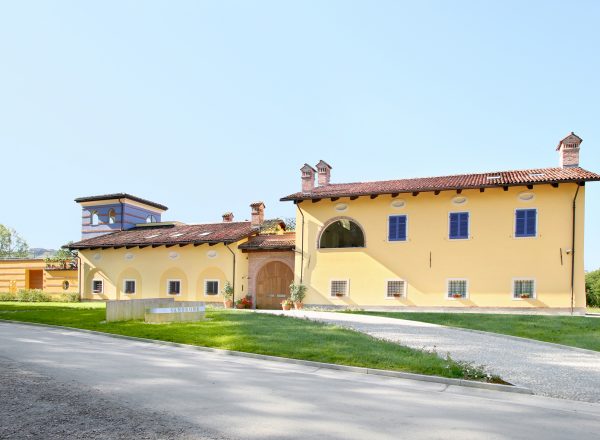
Sandrone
ALESTE Barolo 2016
Barolo
ALESTE is the natural continuity of Luciano’s first wine, the Barolo Cannubi Boschis, which garnered Luciano his early acclaim with the international trade and press. Giving all the experience, knowledge, patience and passion of his many harvests, Luciano pays tribute, with boldness and sensibility, to the next family generation: “ALESTE” is in fact the combination of the names of his grandchildren ALEssia and STEfano.
This single-vineyard wine is typically dense and concentrated but shows incredible harmony and balance. The medium-weight structure shows delightful and seductive notes of berries and cherries, with floral and mineral aspects. In great vintages, properly cellared examples will drink well for 20+ years. The finish is sweet and broad, with moderate, ripe tannins and long length.
VINEYARD

The vineyard is one of the great cru sites in Barolo, synonymous with richness and complexity. Sandrone’s ALESTE Barolo is grown on the soil of Cannubi Boschis, in a specific sub-section of the Cannubi hill. Cannubi extends north from the village of Barolo and has been planted to Nebbiolo on its south and east exposures for at least a century. It runs approximately southwest-northeast and is entirely inside the commune of Barolo, from which it displays the characteristics of wines from this village: profound aromatic complexity and comparatively softer tannins in relation to vines grown in Monforte or Serralunga. The “Boschis” subzone of the Cannubi (also known, historically, as Monghisolfo) is near the northern end of the hill, and is located directly across the little valley from the Sandrone winery building. The Cannubi Boschis subzone has a particularly good exposure to the south and southeast in a small bowl or “conca” that helps hold the warmth in the early morning. Its soils are sea deposits of calcareous clay, not very deep, with good drainage.
WINEMAKING

Each lot of the vineyard is vinified separately, and after destemming and light crushing, the must is covered with CO2 for a gentle warm maceration of approximately a day. Alcoholic fermentation begins about 24-36 hours later from native yeasts. A gentle maceration takes place in upright open-top steel tanks for the first 9-10 days of alcoholic fermentation. Immediately after alcoholic fermentation, which takes 28-30 days, malolactic fermentation takes place in 500 liter French oak casks. The wine is aged in these casks for 24 months, followed by 18 months of bottle aging. Around 800 cases are produced in a typical vintage.
VINTAGE

In 2016, the winter was mild and not snowy. The first weeks of the year were very unusually dry. Precipitation, especially rainfall, came only in February. Spring was cool, especially April and May, with numerous rainshowers. May is oftentimes like an early summer here. In Langa they call it “the May furnace”, but in 2016 it didn’t fire up!
The summer was a season of back-and-forth. The first heat came at the end of June, and from then on, a constant back-and-forth between short periods of warmth (5 to 7 days) and sudden storms which brought cooler temperatures. At the end of August the rhythm changed. The last part of the month and all of September gave us beautiful days. At a certain point, the typical autumn weather began, characterized by warm days and cool nights, with daytime temperatures often reaching 30 degrees C.
In the vineyards of the Langhe and Roero, the weather of 2016 influenced the vegetative cycles of the vine. The lack of winter cold caused an early budding but after its early start, the vegetative cycle de-accelerated. Flowering and fruit set took place slightly later than average, but occurred evenly, thus positively influencing the productivity of the vintage. The slowing of the vegetative cycle was consistent through the summer, and therefore the veraison began 13-15 days later as compared to 2015. This delay influenced the final phases of maturation and the picking times. Each parcel had to be monitored and harvested individually for maximum quality, contingent on its exposition and slope.
Harvest took place from 13th until 22nd October
TASTING NOTE

2016 was a classic vintage of the type that combines power, elegance and drinkability. The Barolo Aleste 2016 has a penetrating dark ruby-garnet color, and aromatics that are characteristic of Nebbiolo: black cherries, rose petals, violets, licorice and a tarry underbrush element.
On the palate, the wine shows the power and structure of the favored parcels on the south-east facing side of the Cannubi hill. Cannubi fruit benefits from the interlaced layers of clay and sand that constitute the hill, and the mouth is filled with black fruits, spice and mineral notes, and subtle hints of vanilla and oak, balancing the wine’s inherent structure with sweetness and lift.
Color
Red
Appellation
Barolo
Farming
Follows organic farming but has chosen not to seek certification. Minimal quantities of Bordeaux mixture and sulfur (as allowed per organic practices) are used to control mold and fungus, and fertilization every 4-6 years occurs with composted manure from dairy cows.
Alcohol
14.5%
Suggested Retail Price
$175.00
Reviews
"Delivers impeccable intensity"

Wine Advocate - July 24, 2020 "The Luciano Sandrone 2016 Barolo Aleste is a very special wine for several reasons. First, we get that exceedingly smooth and seamless quality that we saw in many of the other new releases in this portfolio. This trait sums up the house style. Second, this vintage delivers impeccable intensity that transcends the various fruit, spice, earthy and ethereal components of the bouquet. That equal intensity spread across all parts of the wine is what creates those beautiful transitions. The wine is layered and rich in terms of mouthfeel with a long, fruit and spice-driven finish. The tannins are tucked in at the back, surrounded amply by the wine's textural richness and fruit weight."
"Especially admire the wine's translucence"

Vinous - June 1, 2020
"The 2016 Barolo Aleste is ample, creamy and expansive in feel. But more than that, the 2016 stands out for its freshness, persistence and brilliance. In so many vintages, the Aleste (formerly known as Cannubi Boschis) has been rich and powerful in feel, but in 2016, the wine is all about finesse. The red-fruited, floral purity of Nebbiolo comes through beautifully here; I especially admire the wine's translucence. Wow."
"Both finesse and power"

Wine Spectator - November 11, 2020 "A core of ripe, sweet cherry lurks beneath the iron, tar, eucalyptus and tobacco flavors in this firmly structured red, which shows freshness. This has both finesse and power, with a tight matrix of tannins and a long finish."
"Loaded with finesse"

Wine Enthusiast - June 2, 2020
"Dark berry, exotic spice, blue-flower and menthol aromas take shape on this fragrant red. Full bodied and loaded with finesse, the firm palate doles out juicy morello cherry, raspberry compote, licorice and hints of French oak alongside firm fine-grained tannins."
Trade Materials
Other Wines by this Producer

Dolcetto d’Alba
Dolcetto d'Alba
Sandrone's Dolcetto d’Alba is produced using Dolcetto grapes from 11 different vineyards, all within the Barolo DOCG. Sandrone’s Dolcetto sees no time in wood and is a remarkably robust and complex example of the variety.

Le Vigne Barolo
Barolo
Le Vigne is a wine created from four different Nebbiolo vineyards, each of which brings its own contribution. This union generates an exceptionally complex wine that is round and harmonious on the palate, with fruity and spicy notes, and this approach of blending together plots is in fact the traditional one in Barolo.

Barbera d’Alba
Barbera d'Alba
The Sandrone Barbera d'Alba comes from three vineyards: Merli and Rocche di San Nicola in Novello, and Cascina Pe Mol in Monforte d’Alba. It is widely considered one of the most intense and complex Barberas produced.

Valmaggiore
Nebbiolo d'Alba
Valmaggiore is the product of Luciano’s incredible passion for the Nebbiolo grape variety and its different expression. Just 15 miles away from Barolo, in the Roero region, Nebbiolo produces a lighter structure and ripe, smooth tannins that are not unlike those of Pinot Noir. This is not a “baby Barolo” or a second wine at all – it is a distinct interpretation of Nebbiolo from a completely distinct geographic zone.









